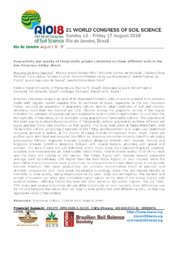Productivity and quality of Tempranillo grapes cultivated on three different soils in the Sao Francisco Valley, Brazil.
Productivity and quality of Tempranillo grapes cultivated on three different soils in the Sao Francisco Valley, Brazil.
Author(s): SANTANA, M. de B.; RIBEIRO FILHO, M. R.; ALMEIDA, B. G. de; PEREIRA, G. E.; CUNHA, T. J. F.; NASCIMENTO, A. M. de S.; COSTA, K. G. da; SOUZA, J. F. de; SILVA, J. F. M.
Summary: Brazilian viticulture ocupies an area of 81 thousand hectares, with vineyards planted from extreme south until regions nearby equator line. At northeast of Brazil, especially at the San Francisco Valley, occured an expansion of grapevine culture, due to ideal conditions of soil and climate, obtaining more than one harvest per year. Studies aiming the grapevine zoning of the region indicates the potential of several cultivars adapted to local conditions and suitable to contribute for the typicality of the wines, as for example, using grapes from Tempranillo cultivar. The objective of this work was to evaluate the productivity of Tempranillo cultivar grapevines on three different soil types and how these soils interfere on fruit quality. The study took place at Santa Maria farm, with Tempranillo cultivar, producing 2 harvests in 2017 (May and November) in an eight year stablished vineyard, growed in spalier, at the county of Lagoa Grande-Pernambuco State, Brazil. Three soil profiles were described and sampled, identified as: Argissolo Vermelho-Amarelo Eutrófico abrúptico plintossólico (Ultisol), Argissolo Amarelo Eutrófico abrúptico (Ultisol), with medium texture and Argissolo Amarelo Eutrófico abrúptico (Ultisol), with coarse texture, abunding with gravel and pebbles. The area of each soil was delimited, and in these areas were harvested grapes, counted, weighed, and measured the pH, total soluble solids (ºBrix), total titratable acidity (TTA) of the must and the mass and volume of 100 berries. The Yellow Argisol with medium texture presented average yield aproximately 20% higher than the Red-Yellow Argisol on both harvest, while the Red-Yellow Argisol presented lower productivity in comparison to the two other types of soil on both harvest. However, this lower productivity can promote concentration levels of phenolic and aromatic compounds, wich have great importance in enology, since they are related directly or indirectly to wine quality, being responsable for its color, body and astringency. The number and weight of bunches per plant also presented higher values on the area of the Yellow Argisol with medium texture, differing statistically from the other areas on the winter harvest. The pH, ºBrix, TTA, mass and volume of bunches did not differ statistically on both harvests. Also, differences can be noticed between the values that can lead to wine production with different quality, so that can aggregate value to the product.
Publication year: 2018
Types of publication: Abstract in annals or event proceedings
Unit: Embrapa Semi-arid Region
Keywords: Solo, Solo Tropical, Tropical soils, Uva, Variedade Tempranillo, Vinho, Vinhos tropicais, Vitis, Vitivinicultura
Observation
Some of Embrapa's publications are published as ePub files. To read them, use or download one of the following free software options to your computer or mobile device. Android: Google Play Books; IOS: iBooks; Windows and Linux: Calibre.
Access other publications
Access the Agricultural Research Database (BDPA) to consult Embrapa's full library collection and records.
Visit Embrapa Bookstore to purchase books and other publications sold by Embrapa.

